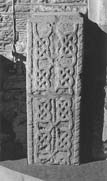Select a site alphabetically from the choices shown in the box below. Alternatively, browse sculptural examples using the Forward/Back buttons.
Chapters for this volume, along with copies of original in-text images, are available here.
Object type: Incomplete grave-cover, in three pieces now joined together
Measurements:
a: L. 63 cm (25 in) W. 21 cm (8 in); D. 15 cm (6 in)
b: L. 60 cm (23.5 in) W. 22 cm (8.5 in); D. 15 cm (6 in)
c: L. 56 cm (22 in) W. 43 > 42 cm (17 > 16.5 in) D. 15 cm (6 in)
Stone type: [Lincolnshire Limestone but not Ancaster or Barnack types, ?of Lincoln vicinity]
Plate numbers in printed volume: Fig. 14; Ill. 69
Corpus volume reference: Vol 5 p. 116-117
(There may be more views or larger images available for this item. Click on the thumbnail image to view.)
A (broad): Small slab or panel, without frame or edge moulding. It stands out a few centimetres ('c. 5 cm', Rodwell 1990, 165) from the rubble wall face, presumably to be flush with or slightly proud of an original plastered surface. Its upper corners are distinctly rounded: its lower end fits closely onto the keystone of the stripwork outlining the arch (which is similarly of gritstone) and may have been cut in a curve to do so. All superficial decoration (if any formerly existed) has been trimmed or scraped off leaving prominent rough tooling marks. Rodwell reports from close examination that 'the sculpture is as complete as it was intended to be... nothing has been hacked away' (Rodwell 1990, 165). All that survives is an egg-shaped head with pointed chin (?i.e. bearded), that is defined by a deep incision and therefore appears recessed in low relief into the stone's surface. The head is placed centrally against the upper edge of the slab; it is frontal and upright; and eyes (set high in the head), a rectangular nose and a straight mouth can all be clearly distinguished.
This is part of an interlaced grave-cover of Lindsey type discussed in Chapter V. Though by virtue of its single cable border it would fall within group (b), this cover is unusual within the type and within the sub-group in more than one way, and is best considered within a separate group (c) (see Table 6 and Fig. 14). (i) It has only two lines or registers of interlace, whereas every other example in the cover type where the pattern width can be established has three lines. The only other exception is the cover at Cumberworth (Ill. 151), which is also divided longitudinally by a cabled rib. In that example, however, the rib appears to divide the surface into distinct panels and may be respected not broken through by the interlace. (ii) As a corollary, it is rather narrower than the norm for covers of this category, though still within the known range. More striking is its length relative to its width, and if it had originally been split crossways into three pieces it might have measured as much as 180 cm (70 in). (iii) It is unusually but consistently lopsided in its layout, with the paired units not held in regular rows as tends to be the case with three registers. Since this occurs on the large fragment 1c, its appearance on the conjoined fragments 1a and b tends to confirm rather than question the recon-struction's correctness. (iv) On 1c there is clearly a median cabled ridge that finds no parallel on the other covers in the category except at Cumberworth. This feature has been lost on the two smaller conjoined fragments through the process of splitting. This raises the possibility that a cross-bar of similar form formerly existed along the line of the cross-wise splitting of the slab. Though the rib is not strictly a continuous or coherent feature (for the interlace pattern crosses through it), the effect would have been to insert a cross motif into the standard Lindsey design. Its form would bear some comparison with the narrow cabled cross-stem on Cross Canonby 4, Cumberland (Bailey and Cramp 1988, 89, ills. 222–3), and more generally with covers with a rectangular cross (type A1) embedded in interlace, like several from York Minster (Pattison 1973; Lang 1978b, 19–20; id. 1991, 72–5), York St Mary Bishophill Senior 11 (Lang 1991, 92, ill. 280, without cable border), Hickling, Nottinghamshire (Hill 1916, 204–5), or the Soke of Peterborough (Irvine 1889a; Fox 1920–1). It suggests a degree of hybridization of decorative traditions that may point to a later rather than earlier date within the Lindsey group of covers.



